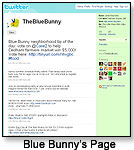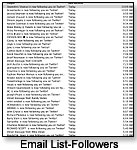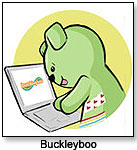|
|
Why Twitter May Be Worth the Time Toy Companies Tweet for News, Reviews and Sales
Near the end of July, Flying Pig Games was celebrating its first order via Twitter — direct from a toy store, Dancing Bear Toys in Frederick, Md., that had been introduced to the new Jukem football card game during an in-store demo by the inventor. It can also be a boon for new businesses.
How did he do it? “It is half technical, half common sense,” said Burginger, who recommends employing second-party applications such as TweetDeck, Twitter Karma and Twellow, which he lauds as the most important, as “it is like the Yellow Pages of Twitter.” He advocates registering oneself in various applicable categories, as well as searching categories and starting to follow relevant feeds. TWEETING IS WORK
In some cases, that job is being picked up by PR firms, for which social media is becoming a central and relevant part of new product promotion, especially on a tight budget. Hans Eich, founder of Canadian toymaker Ukoonto, hired BizSolutionsPlus to generate buzz via Twitter and blogging for his new business — toy building blocks made from Canadian maple. Through the firm's efforts, Eich’s story was picked up by local media, and later, the Toronto Globe and Mail, which led to several business contacts in Canada and Europe. PROMOTION OR SALES? The big question is, does the Twitter “job” actually pay for itself? The answer? Not directly, in many cases, although sales aren’t unrealistic. “Up to now, we have got only a few direct sales from persons that first saw us on Twitter, but that's still fine as this is a free advertising channel,” Imants Caklais, CEO of Paperlandmarks, told TDmonthly in June. “And we have got some interested retailers who hopefully might turn into actual resellers in the near future.”
“As an experiment, I did a one-day, 20-percent off sale with a Twitter code and only posted it on Twitter to see if anyone would use it, and no one did,” she said. “But, Twitter is just one more way to get the brand out there to more people.” Burginger’s Qubits have definitely received significant exposure. “We have been fortunate to land a few toy reviews, which will help promote our new product further,” he added.
Some, like Imants, who began Tweeting just this year, already feel that Twitter is “worth every minute.” Follow ToyDirectory on Twitter TWITTER DO’S AND DON’TS* Twitter is simple — posting messages in 140 characters or less that answer the question, “What are you doing right now?” But utilizing the platform to the best of one’s professional ability isn’t as easy. Following are tips to provide guidance when tweeting: DO • Stake Your Claim. Create an account with your company or brand name on Twitter now, even if you’re not going to use it right away. Squatters have already reserved some brand handles, as they did with Internet domain names. • Follow With Discretion. Followers are fellow Tweeters who subscribe to your tweets. Don’t feel that you have to follow everyone who follows you; rather, choose to follow Tweeters based on similar interests and valuable content. • Be Clear About Your Identity. Since networking sites blur the line between personal and professional, it’s important to identify who you represent and your reason for being on Twitter — then make sure your posts reflect those distinctions. • Humanize Corporate Tweets. While still maintaining professionalism, ensure that your messages don’t duplicate traditional marketing or corporate copy. Make them enjoyable and relevant to your audience. Burginger advised, “Concentrate on wooing your biggest followers. See what they like to Re-Tweet and then give them that material.” • Generate Traffic. Posting interesting and relevant content for your followers may involve linking to press releases, promotions and recalls, or direct to news on your own website. • Tweet Carefully. Twitter posts are published to the public, and can be found via Google or other search engines. So, watch your language and be careful that in such brief phrasing, your post isn’t something that could be misunderstood for the worst. • Guard Your Twitter Stream. If you follow a lot of accounts, the tweets appearing on your homepage can become overwhelming. Check out profile pages before clicking “follow,” and avoid power Tweeters who post nonstop. “If you are building a following for numbers,” Burginger added, “you will at times need to purge your follows. Many people don't follow back and they will keep you from growing your numbers. Delete them with something like Twitter Karma, then start finding new, interesting people to follow.” • Track Customer Talk. Type in your company or brand name at Search Twitter to find out what’s being said. You can also track customers’ upkeep with your competitors and the industry at large via this tool. Furthermore, use the platform to respond to questions from customers. DON’T • Spam. This is a sure way to antagonize followers and create an unwanted reputation with your audience. • Be Silent. You have a Twitter account, so use it. Your followers expect activity from you on a fairly regular basis. Also, Twitter encourages two-way communication, so get involved in what others are saying. • Be Excessive or Mundane. Respect your own time and your followers’ time by not submitting too many updates. Also, avoid excessive tweeting of the same content and boring messages that don’t add value to a conversation. *Sources: “Twitter Etiquette: Five Dos and Don’ts,” “Why the World is Twitter Crazy," , “Business Uses for Twitter” and Mark Burginger of Qubits Toy Co. What do you think? Is Twitter worth it for your business? Leave a comment below.  Writer's Bio: Julie L. Jones has written articles for both newspapers and magazines. Before joining the staff of TDmonthly Magazine, she worked as a communications writer and provided editorial support for a market research company. Read more articles by this author Writer's Bio: Julie L. Jones has written articles for both newspapers and magazines. Before joining the staff of TDmonthly Magazine, she worked as a communications writer and provided editorial support for a market research company. Read more articles by this author |
| |||||||||||||||||||||||||||||||||
Disclaimer Privacy Policy Career Opportunities
Use of this site constitutes acceptance of our Terms of Use.
© Copyright 2025 PlayZak®, a division of ToyDirectory.com®, Inc.


 “We recently tweeted an event [that was] picked up by fellow tweeter KidoInfo, who blogged a review,” General Manager Janet Reynolds told TDmonthly. “That was picked up by Google Alerts [and was] sent via email to us. We picked it up as a Facebook update and Tweet, which was picked up by other Tweeters.”
“We recently tweeted an event [that was] picked up by fellow tweeter KidoInfo, who blogged a review,” General Manager Janet Reynolds told TDmonthly. “That was picked up by Google Alerts [and was] sent via email to us. We picked it up as a Facebook update and Tweet, which was picked up by other Tweeters.” “My pastime hobby is nature photography, which has interested many followers,” said Mark Burginger, CEO of
“My pastime hobby is nature photography, which has interested many followers,” said Mark Burginger, CEO of  “Companies that want to have a Twitter presence need to realize it basically generates a new job position,” Burginger said. “Someone at the company will need to give it time, patience and effort. At least 20 hours a week to have progressive success. My son is a computer expert (works for Apple iPhone division) — he sees the potential to be hired by many companies to manage their online presence. It is a job, plain and simple.”
“Companies that want to have a Twitter presence need to realize it basically generates a new job position,” Burginger said. “Someone at the company will need to give it time, patience and effort. At least 20 hours a week to have progressive success. My son is a computer expert (works for Apple iPhone division) — he sees the potential to be hired by many companies to manage their online presence. It is a job, plain and simple.” Emily Ross, founder of
Emily Ross, founder of  Only time will tell whether brand-building through Twitter ultimately reaches the bottom line, but regardless, many companies quickly become attached to the social connections and business potential it yields.
Only time will tell whether brand-building through Twitter ultimately reaches the bottom line, but regardless, many companies quickly become attached to the social connections and business potential it yields.

